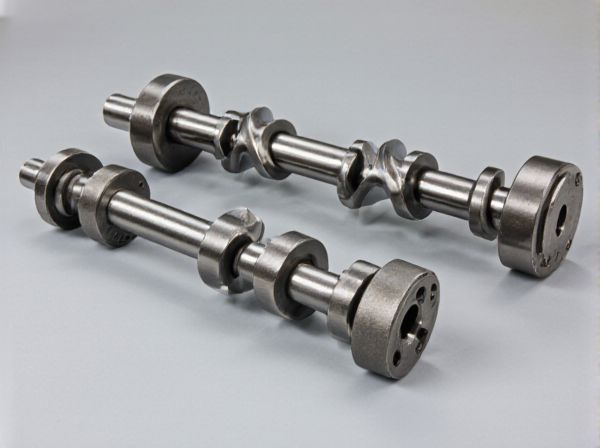
Photo illustration: Nitrided crankshaft vs Non-nitrided crankshaft
A nitrided crankshaft undergoes a surface hardening process that improves wear resistance, fatigue strength, and corrosion protection, extending the component's lifespan. Non-nitrided crankshafts lack this treated layer, making them more susceptible to surface wear and potential deformation under stress. Choosing a nitrided crankshaft enhances your engine's durability and performance, especially in high-stress applications.
Table of Comparison
| Feature | Nitrided Crankshaft | Non-Nitrided Crankshaft |
|---|---|---|
| Surface Hardness | High hardness due to nitriding process | Lower hardness, untreated surface |
| Wear Resistance | Excellent wear and fatigue resistance | Moderate wear resistance |
| Corrosion Resistance | Improved corrosion resistance | Standard corrosion resistance |
| Manufacturing Cost | Higher cost due to additional nitriding step | Lower cost, simpler manufacturing |
| Performance | Better durability and longevity | Normal durability |
| Application | High-performance and heavy-duty engines | Standard passenger vehicles |
Introduction to Crankshaft Types
Nitrided crankshafts undergo a surface hardening process that enhances fatigue resistance and wear properties, making them ideal for high-performance or heavy-duty engines. Non-nitrided crankshafts, typically made from forged steel or cast iron, rely on their base material strength and require additional heat treatments for durability. Choosing between nitrided and non-nitrided crankshafts depends on the engine's operational demands, with nitrided types offering superior surface hardness and corrosion resistance.
What is a Nitrided Crankshaft?
A nitrided crankshaft undergoes a specialized surface hardening process called nitriding, where nitrogen atoms diffuse into the metal's surface to create a hard, wear-resistant layer. This treatment enhances fatigue strength, reduces friction, and improves corrosion resistance compared to non-nitrided crankshafts. As a result, nitrided crankshafts provide longer durability and better performance in high-stress engine conditions.
What is a Non-Nitrided Crankshaft?
A non-nitrided crankshaft is manufactured without undergoing the nitriding process, leaving the metal surface untreated and maintaining its original hardness and tensile strength. These crankshafts typically rely on traditional heat treatment methods like carburizing or induction hardening to achieve durability and wear resistance. Compared to nitrided crankshafts, non-nitrided versions may exhibit lower surface hardness and reduced resistance to fatigue and corrosion under high-stress engine conditions.
Manufacturing Process Differences
Nitrided crankshafts undergo a specialized surface hardening process called nitriding, where the steel is exposed to nitrogen-rich gas at high temperatures, creating a hard, wear-resistant outer layer without altering the core properties. Non-nitrided crankshafts typically rely on conventional heat treatments such as carburizing or induction hardening, which may not achieve the same depth or uniformity of surface hardness. The nitriding process enhances fatigue strength and corrosion resistance, making nitrided crankshafts preferable for high-performance and heavy-duty engines.
Material Hardness Comparison
Nitrided crankshafts exhibit significantly higher surface hardness compared to non-nitrided crankshafts due to the diffusion of nitrogen into the steel surface, which forms a hard, wear-resistant layer. This enhanced hardness improves fatigue resistance and reduces surface wear, making nitrided crankshafts more durable under high-stress engine conditions. In contrast, non-nitrided crankshafts rely solely on the base material hardness, which is generally lower and more susceptible to surface damage and deformation over time.
Durability and Wear Resistance
Nitrided crankshafts exhibit superior durability and wear resistance compared to non-nitrided crankshafts due to the hardened surface layer created through the nitriding process, which enhances fatigue strength and reduces susceptibility to surface wear. This surface modification results in increased resistance to abrasion, pitting, and corrosion, extending the crankshaft's operational lifespan under high-stress conditions. Non-nitrided crankshafts, lacking this hardened layer, are more prone to surface deformation and faster degradation during prolonged engine use.
Performance Impact in Engines
Nitrided crankshafts exhibit superior surface hardness and wear resistance compared to non-nitrided crankshafts, resulting in enhanced fatigue strength and longer engine lifespan. The nitriding process significantly reduces friction and improves lubrication efficiency, which leads to better engine performance and fuel economy. Non-nitrided crankshafts may suffer from higher wear rates and reduced durability under heavy load conditions, negatively impacting overall engine reliability and output.
Cost and Availability Analysis
Nitrided crankshafts typically cost more due to the specialized heat treatment process that enhances surface hardness and wear resistance, leading to extended service life and reduced maintenance expenses. Non-nitrided crankshafts are generally more affordable and widely available, making them a preferred choice for budget-sensitive applications despite shorter durability. Availability of nitrided crankshafts may be limited to performance or heavy-duty markets, whereas non-nitrided variants are mass-produced and readily accessible in standard automotive and industrial sectors.
Common Applications for Each Type
Nitrided crankshafts are commonly used in high-performance engines, such as those found in racing cars, motorcycles, and heavy-duty diesel engines, due to their enhanced surface hardness and improved fatigue resistance. Non-nitrided crankshafts are typically found in standard passenger vehicles and light trucks where manufacturing costs are lower and the operating conditions involve less stress and lower RPM ranges. Industrial machinery and marine engines often use non-nitrided crankshafts because of their suitability for moderate performance requirements and easier maintenance.
Choosing the Right Crankshaft for Your Engine
Nitrided crankshafts offer enhanced surface hardness and improved fatigue resistance compared to non-nitrided crankshafts, making them ideal for high-performance or heavy-duty engines demanding greater durability. Non-nitrided crankshafts may be more suitable for standard, lower-stress applications where cost-effectiveness and ease of machining are prioritized. Selecting the right crankshaft involves balancing performance requirements, engine load, and budget considerations to ensure optimal engine longevity and efficiency.
 caratoz.com
caratoz.com